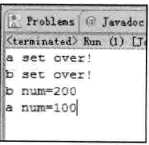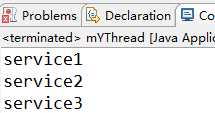标签:read 对象 创建 nts 访问 try oid data ice
论:“线程安全”与“非线程安全”是多线程的经典问题。synchronized()方法就是解决非线程安全的。
1、方法内的变量为线程安全
public void addI(String username) { try { int num = 0; \\方法内的变量为线程安全 if (username.equals("a")) { num = 100; System.out.println("a set over!"); Thread.sleep(2000); } else { num = 200; System.out.println("b set over!"); } System.out.println(username + " num=" + num); } catch (InterruptedException e) { // TODO Auto-generated catch block e.printStackTrace(); } }
2、实例变量非线程安全
public class HasSelfPrivateNum { private int num = 0; \\实例变量非线程安全 public void addI(String username) { try { if (username.equals("a")) { num = 100; System.out.println("a set over!"); Thread.sleep(2000); } else { num = 200; System.out.println("b set over!"); } System.out.println(username + " num=" + num); } catch (InterruptedException e) { // TODO Auto-generated catch block e.printStackTrace(); } } }
解决方法: 方法前加synchronized关键字。
public class HasSelfPrivateNum { private int num = 0; synchronized public void addI(String username) { .............. } }
3、多个对象多个锁
HasSelfPrivateNum.java
public class HasSelfPrivateNum { private int num = 0; synchronized public void addI(String username) { try { if (username.equals("a")) { num = 100; System.out.println("a set over!"); Thread.sleep(2000); } else { num = 200; System.out.println("b set over!"); } System.out.println(username + " num=" + num); } catch (InterruptedException e) { // TODO Auto-generated catch block e.printStackTrace(); } } }
ThreadA
public class ThreadA extends Thread {
private HasSelfPrivateNum numRef;
public ThreadA(HasSelfPrivateNum numRef) {
super();
this.numRef = numRef;
}
@Override
public void run() {
super.run();
numRef.addI("a");
}
}
ThreadB
public class ThreadB extends Thread { private HasSelfPrivateNum numRef; public ThreadB(HasSelfPrivateNum numRef) { super(); this.numRef = numRef; } @Override public void run() { super.run(); numRef.addI("b"); } }
RUN
public class Run { public static void main(String[] args) { HasSelfPrivateNum numRef1 = new HasSelfPrivateNum(); HasSelfPrivateNum numRef2 = new HasSelfPrivateNum(); ThreadA athread = new ThreadA(numRef1); athread.start(); ThreadB bthread = new ThreadB(numRef2); bthread.start(); } }
结果:创建了2个业务实例,产生2个锁,所以运行结果是异步的。同步为synchronized 异步:asynchronized

4、synchronized 锁重入
当一个线程得到一个对象锁时,再次请求该对象锁时是可以再次得到该对象的锁的。继承关系也可重入锁。
当一个线程执行发生异常时,其持有的锁会自动释放。
同步不具有继承性。的在子类方法中添加synchronized的关键字。

public class HasSelfPrivateNum { synchronized public void service1() { System.out.println("service1"); service2(); } synchronized public void service2() { System.out.println("service2"); service3(); } synchronized public void service3() { System.out.println("service3"); } }

public class mYThread extends Thread { @Override public void run() { HasSelfPrivateNum hspn=new HasSelfPrivateNum(); hspn.service1(); } public static void main(String[] args) { mYThread mYThread=new mYThread(); mYThread.start(); } }

synchronized同步方法持有锁后,如果长时间不释放,那另一个线程就必须长时间等待。。这种情况下synchronized同步快来解决
使用方法如图:
1、synchronized同步快之间具有同步性,当线程访问object的一个 synchronized(this)同步代码块时,其他线程对同一个object对象中所有其他的
synchronized(this)同步代码块的访问会被阻塞。
2、synchronized(this)同步代码块是锁定当前对象的。

1、synchronized同步快解决同步方法效率低得弊端

public class Task { private String getData1; private String getData2; public synchronized void doLongTimeTask() { try { System.out.println("begin task"); Thread.sleep(3000); getData1 = "长时间处理任务后从远程返回的值1 threadName=" + Thread.currentThread().getName(); getData2 = "长时间处理任务后从远程返回的值2 threadName=" + Thread.currentThread().getName(); System.out.println(getData1); System.out.println(getData2); System.out.println("end task"); } catch (InterruptedException e) { // TODO Auto-generated catch block e.printStackTrace(); } } }

public class MyThread1 extends Thread { private Task task; public MyThread1(Task task) { super(); this.task = task; } @Override public void run() { super.run(); CommonUtils.beginTime1 = System.currentTimeMillis(); task.doLongTimeTask(); CommonUtils.endTime1 = System.currentTimeMillis(); } }

public class MyThread2 extends Thread { private Task task; public MyThread2(Task task) { super(); this.task = task; } @Override public void run() { super.run(); CommonUtils.beginTime2 = System.currentTimeMillis(); task.doLongTimeTask(); CommonUtils.endTime2 = System.currentTimeMillis(); } }

public class CommonUtils { public static long beginTime1; public static long endTime1; public static long beginTime2; public static long endTime2; }

public class Run { public static void main(String[] args) { Task task = new Task(); MyThread1 thread1 = new MyThread1(task); thread1.start(); MyThread2 thread2 = new MyThread2(task); thread2.start(); try { Thread.sleep(10000); } catch (InterruptedException e) { e.printStackTrace(); } long beginTime = CommonUtils.beginTime1; if (CommonUtils.beginTime2 < CommonUtils.beginTime1) { beginTime = CommonUtils.beginTime2; } long endTime = CommonUtils.endTime1; if (CommonUtils.endTime2 > CommonUtils.endTime1) { endTime = CommonUtils.endTime2; } System.out.println("耗时:" + ((endTime - beginTime) / 1000)); } }

修改Task

public class Task { private String getData1; private String getData2; public void doLongTimeTask() { try { System.out.println("begin task"); Thread.sleep(3000); String privateGetData1 = "长时间处理任务后从远程返回的值1 threadName=" + Thread.currentThread().getName(); String privateGetData2 = "长时间处理任务后从远程返回的值2 threadName=" + Thread.currentThread().getName(); synchronized (this) { getData1 = privateGetData1; getData2 = privateGetData2; } System.out.println(getData1); System.out.println(getData2); System.out.println("end task"); } catch (InterruptedException e) { // TODO Auto-generated catch block e.printStackTrace(); } } }

四、java多线程核心技术——synchronized同步方法与synchronized同步快
标签:read 对象 创建 nts 访问 try oid data ice
原文地址:http://www.cnblogs.com/aGboke/p/6523365.html